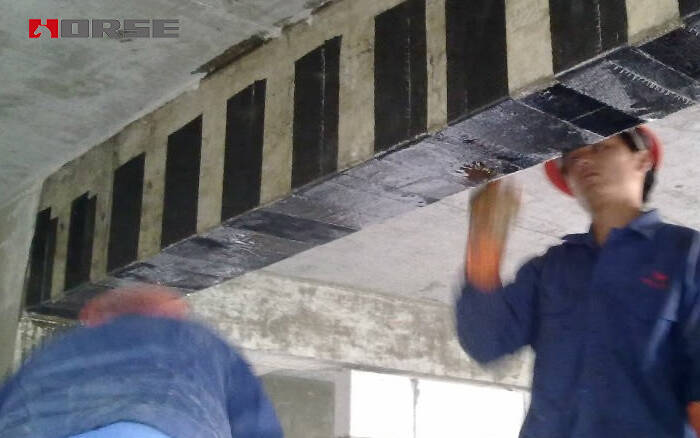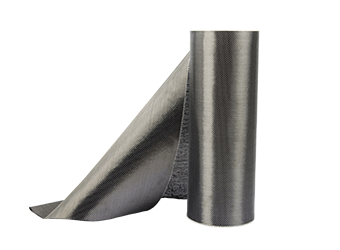Solutions
Horse Construction offers full range of structural strengthening materials with technical supports, documentation supports, products supports, project supports.
Unidirectional carbon fiber used for reinforcement and repair of concrete bending members

With the deepening of research on composite materials, unidirectional carbon fiber composite materials, as a substitute or supplementary material for conventional building materials such as steel, wood and concrete, will be increasingly used in civil engineering. Compared with conventional materials, the main advantages of this type of composite material are: light weight, more suitable size and better thermal stability, good corrosion resistance, high specific strength, and good fatigue resistance. By changing the component materials and layout design, it can have many non-structural properties, such as anti-radar reflection, electromagnetic properties and acoustic damping. At present, this type of composite material is mainly used as structural materials, such as bridges, building structures and marine engineering, as the main force-bearing components and structural materials. Some structural components in civil engineering can also be reinforced or repaired to improve the performance of components.
The use of unidirectional carbon fiber resin composite materials to repair, strengthen, renovate and wrap concrete members and structures has very important practical significance. Relevant statistics show that nearly 40% of the existing 572,729 highway bridges in the United States are considered to have structural and functional defects, and maintenance work is very heavy. The steel plate repair method used in the house has disadvantages such as high quality, high rigidity, incomplete bonding with components, poor corrosion resistance, and reinforcement effect cover, and its use is limited. The use of unidirectional carbon fiber resin composite materials to reinforce and repair concrete components avoids the defects of the steel plate repair and reinforcement method and will create greater economic and social benefits.
Strengthening effect of different layers of unidirectional carbon fiber cloth on concrete specimens
The results show
(1) As the number of unidirectional carbon fiber cloth layers increases, the maximum breaking load gradually increases, showing a very obvious reinforcement effect. Compared with the matrix concrete sample without unidirectional carbon fiber cloth, when one layer of unidirectional carbon fiber cloth is applied, the breaking load increases by 103%. When 2 layers of unidirectional carbon fiber cloth are attached, the breaking load increases by 201%; when 3 layers of unidirectional carbon fiber cloth are attached, the breaking load increases by 257%
(2) Sticking unidirectional carbon fiber cloth on the concrete surface can increase the ultimate displacement at break by more than 300%. The ultimate displacement when the specimen is broken corresponds to the degree of milling of the specimen, and the increase in the ultimate displacement reflects the increase in the flexibility of the specimen, that is, the increase in the reliability of the material. Therefore, sticking unidirectional carbon fiber cloth on the surface of the concrete can significantly strengthen the concrete. From an economic and practical point of view, if there are no special requirements, it may be more appropriate to stick two layers of unidirectional carbon fiber cloth, because sticking two layers of unidirectional carbon fiber cloth can increase the strength of the concrete by more than 2 times, which has been greatly improved. The destructive resistance of concrete. And sticking more unidirectional carbon fiber cloth will further increase the strength of the concrete, but the increase will be reduced, and it will undoubtedly increase the cost.
Repairing effect of unidirectional carbon fiber cloth/epoxy resin composite on concrete specimens with gaps
It can be seen from the figure:
(1) Before fracture, the limit displacement of the concrete specimen (unrepaired) is less than 1 mm, the allowable deformation is very small, and the maximum load that can be withstood is about 40% of the maximum load (110 kN) of the same complete concrete specimen. %. The specimens repaired with epoxy putty and pasted with 2 layers of unidirectional carbon fiber cloth, the fracture displacement increased by about 35 times, the maximum load increased by 9 times, showing that the unidirectional carbon fiber cloth has a very good repair effect on the defective concrete
(2) Reinforce the concrete specimen with unidirectional carbon fiber cloth, regardless of whether the concrete has prefabrication defects, its failure load remains at the same order of magnitude, indicating that the use of unidirectional carbon fiber cloth to reinforce or repair concrete has achieved good results
Fracture process of concrete specimens reinforced with unidirectional carbon fiber composites during bending failure
It can be seen from the destruction process of the concrete components that the interface bonding state between the unidirectional carbon fiber cloth/epoxy resin composite material and the concrete is an important factor affecting the reinforcement effect of the unidirectional carbon fiber cloth composite material. The epoxy resin with high shear strength should be selected, and the interface should be properly treated
You can find anything here you are in need of, have a trust trying on these products, you will find the big difference after that.

High strength carbon fiber reinforced polymer (CFRP) strip / laminate / plate for structural strengthening and concrete repair

High strength, unidirectional carbon fiber fabric pre-saturated to form a carbon fiber reinforced polymer (CFRP) fabric used to strengthen structural concrete elements.

High strength, unidirectional carbon fiber sheet pre-saturated to form a carbon fiber reinforced polymer (CFRP) sheet used to strengthen structural concrete elements.